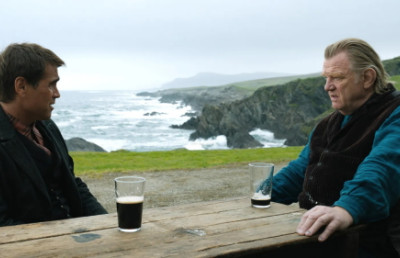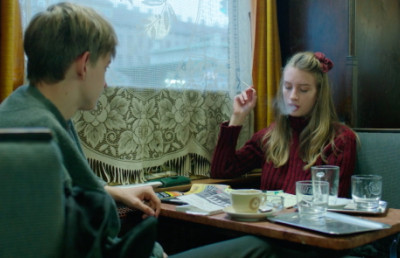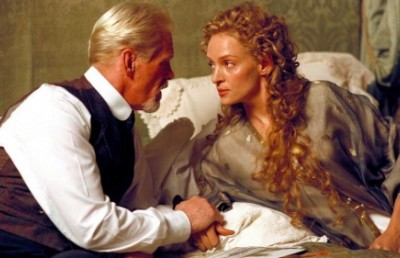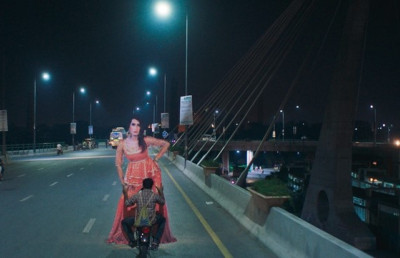1917: The ‘Hard Work’ of the Digital Long Take
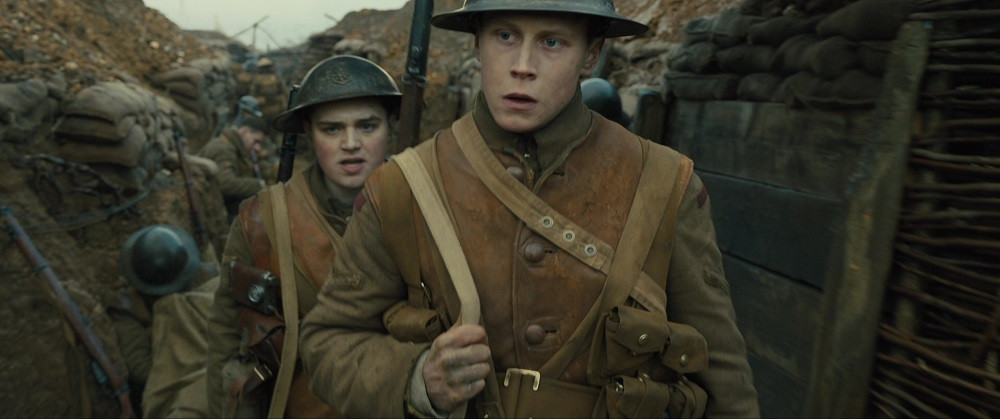
Sam Mendes’ World War 1 drama 1917 earned many prizes and accolades when it was released in 2019. The drama is loosely based on real events as told by the director’s grandfather Alfred Mendes who served in World War 1. While emotionally engaging the story is not any more original than many other war films that revolve around heroic acts of valor and bravery. What makes the film stand out as an achievement is, though not exclusively, its insistence on maintaining the illusion of a single, continuous shot. The combination of cinematography Roger Deakins (and his team of assistants, grips, etc.), director Sam Mendes and the art and set design crews designed the film to move in what some industry insiders refer to as “oners”: continuous long takes that either do not conclude with an edit; or are stitched together in one of many ways, digitally edited or through what I call “mise-en-trickery”, which is when the edit is hidden within the details of the shot, like a dark coat, a black space, a piece of furniture, a character walking past the camera, or within a whip pan, to suggest the illusion of a single shot.
Since the gradual shift to digital filmmaking from around 2010 onwards there has been a marked increase in these type of films, largely due to how digital technology facilitates extreme long takes from a technical standpoint. Without the single magazine limit of 16mm or 35mm filmmaking which limited a shot to roughly ten minutes, before the need to physically change the film magazine, digital cameras can film continuously thanks to a different means of capturing and recording on a hard drive, a memory card, computer, etc. One of the first examples of this in the early stages of digital technology was Alexandre Sokurov’s 2002 The Russian Ark, which recorded its 99 minute Steadicam journey through the Russian Armitage Museum onto an attached hard disk. Of course single take films were always theoretically possible in the pre-digital age with high levels of choreographic labor and mise en trickery. The classic template film being Alfred Hitchcock’s Rope (1948), which matched plot time and story time to its screen time by “hiding” half of the edits (most people forget that there were also five ‘hard cuts’ in the film). A later film influenced by Rope is Josh Brecker’s Running Time (1997), which echoes classic early ‘real time’ film noirs (The Set-up, DOA) by matching plot time and screen time in a heist film that charts a character (played by Bruce Campbell) being released from prison and going immediately to a bank heist he planned from the inside. The 70 minute film goes one further than Rope by hiding all of its 29 cuts by swish pans or objects in the frame (doors, shirts, bodies, etc.).
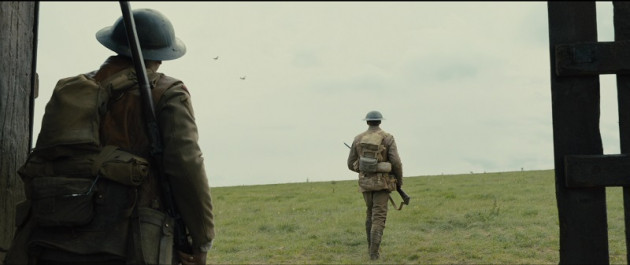
1917
While there have always been single take films pre and post-digital, proving the adage “when there’s a will there’s a way”, there is also no doubt that they have increased ten-fold since digital filmmaking became the norm. And what is interesting is that the use of the “oner” cuts across television and film and cuts across all genres and all budget scales and National cinemas. In fact, the single take real time narrative has become a common aesthetic choice for low budget filmmakers, which may seem counter-intuitive when you factor in how much time (which often translates to money in filmmaking) preparation, planning and mapping out is involved in sustaining the long take. So we have cases where it appears in a big budget Hollywood film, like Birdman and 1917, and in small micro budget films like La Casa Muda (Gustavo Hernández, 2010, Uruguay), The Silent House (Chris Kentis, Laura Lau, 2011, US), Let’s Scare Julie (Jud Cremata, 2019 US), Soft & Quiet (Beth de Araújo, 2022, US), Beyond the Infinite Two Minutes (Junta Yamaguchi, 2020, Japan), One Cut of the Dead (Shinichirou Ueda, 2017, Japan), Crazy Samurai Musashi (Yuji Shimomura, 2020, Japan) and The Body Remembers When the World Broke Open (Kathleen Hepburn, Elle-Máijá Tailfeathers, 2019, Canada). Mike Flanagan recounts the trials and tribulations of his decision to shoot one of the Netflix Hill House episodes (#6) in a series of five ‘stitched’ long takes, building specially designed adjacent sets that involved rigorous rehearsing. After he finished that episode Flanagan admitted that it was the hardest thing he ever did and though happy with the result and buzz the episode garnered, he would think twice before ever trying it again! Clearly the type of plot your telling and action that is involved has much to do with how difficult the single take conceit can be (Does it take place across many locations or is it confined to one? Are there many characters or a few? Is there a lot of dialogue or very little? Is there a lot of character movement or is it mainly static?). But what this tells us is that the single take (real time or not) aesthetic is a highly pliable device which can be adapted to all budgets and genres.
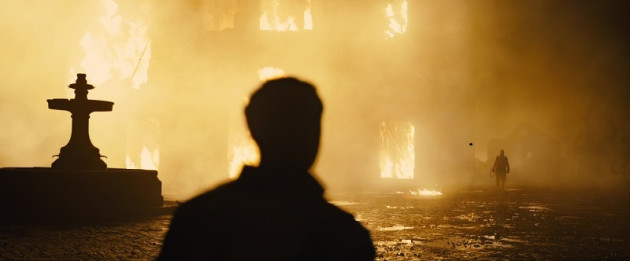
1917
In the general sense the single take film comes in two flavors: those that are narratively meant to take place in real time (story time = screen time). And those that contain some narrative ellipsis and are using the long take gesture for some other narrative, aesthetic or thematic reason. Within these two types there are those films which are genuinely filmed without edits (if we believe the filmmakers, Victoria, Sebastian Schipper, 2015, Germany, Utøya: July 22 Erik Poppe, 2018, Norway and Russian Ark are a few examples). And even some ‘one-take’ ‘auteurs’: Iranian director Shahram Mokri has directed two one-take films, Invasion (2017) and Fish & Cat (2013).
And yet even with the glut of one-take films in recent years Mendes’ 1917 seems to stand out from the pack, for reasons that are partly technical but also because of the scale of the film. The story is not told in real time because a scene a little over an hour mark of the two hour film has the lead character Lance Corporal Schofield (George MacKay) knocked unconscious during a violent encounter with a German sniper. The scene goes to black for fifteen seconds and when the scene fades back in, as Schofield wakes up, the story has moved from night time to day time. In a clever meta-moment (in a film which is clearly classical in its narrative intent) Schofield taps his wrist watch to let the audience know that his watch has stopped working, which in effect is also telling us that Mendes and editor Lee Smith have stopped our sense of time –we can’t know just how much time has passed– which succeeds in marking an ellipsis from night to day while still maintaining the feel of real time. It is a brilliant solution to an aesthetic problem.
What also sets this film apart from low budget one-takers is that it has the great advantage of the full technical power of a major Hollywood production where digital post-production is concerned. And it makes great use of it to disguise the edits through digital stitching (in his commentary track for the Blu Ray Roger Deakins referred to the stitches as ‘blends’). For example, they were able to shoot the actors and then composite in missing details of the shot (trees, bodies, etc.). Or in some cases they were able to do second takes without the actors that way if they needed to do something in terms of compositing they could do it without worrying about the actors. In one scene they had to move from one trench to another because the first trench was not long enough for the complete movement of the actors so they added a shadow digitally to help hide the transition to a second trench (revealed by Deakins in the commentary track).
Given the complexity and scope of movement across the different spaces and locations some ‘blends’ were required to hide a necessary shift from one camera apparatus to another. For example, at the 40 minute mark when Lance Corporal Schofield moves from the fields into the farmhouse Deakins notes that there was a blend to transition from the Stabileye to a Steadicam.
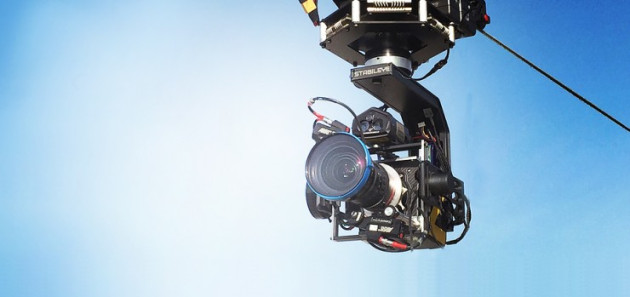
In the above mentioned scene where Schofield wakes up from his black out (67 minutes), the camera is on a Trinity rig to film Schofield’s face from close up overhead, but when he gets up and walks up a set of stairs to the top floor, where we see the church yard lit by flares through a window, there is a blend which disguises a practical switch of the camera to a 50 foot Technocrane, which had to be accommodated by knocking out the back part of the set. The length of the Technocrane enabled the camera to move beyond the windows (which were specially built to part open to allow for the camera). Hence in this one complex “stitched” long take the illusion was facilitated by the close co-operation of set construction, camera rig technology, lighting and post-production visual effects. Needless to say all this technology and computing power requires a budget far beyond the means of smaller films. But in other more intimate, emotional moments simple ‘real’ long takes are used that require little technological capital. One of the best examples is Corporeal Blake’s death scene, which is handled in a very long take which has continual small movements which keep the two characters in constant relief to the idyllic and chaotic landscape. The audience does not see anything the characters don’t see. Blake’s death occurs “on camera”, and a subtle dolly movement around he two grounded men that follows Schofield removing Blake’s name tag and placing it in his pocket. This gesture gives the camera motivation to dolly around to see him holding Blake’s photo and then back around 360 degrees to Schofield’s face.
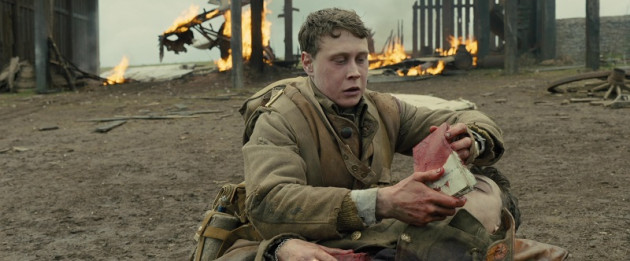
1917: Long Take intimacy
If a film is not using the oner long take device to appropriate a real time narrative, for what other reasons might a filmmaker choose to shoot their film in this decidedly harder (and in some ways more restrictive) way? I will offer a few common reasons cited by many and then propose my own unique theory on the use of the oner in 1917. The most commonly stated reason is that shooting with a long take style brings in an added level of realism. This idea is a long standing one which goes back to the great French film thinker André Bazin, who was the first person to align a moral and philosophical responsibility onto film style. Bazin argued that filming in a long take, mise en scene style with minimal editing is a more realistic temporal and spatial representation of the real world. To clarify my own read of this, realism here is not meant to equate with an objective or unbiased view of the world, but as a relative stylistic term: long take is a more realistic style. Which does not mean it is presenting a ‘purer’ untarnished, unbiased view of the world. As Bazin always noted, art is artifice. When presented with a film that extensively uses the long take style, audiences are more likely to perceive the event as a more realistic visual experience (of course it could also be seen by some as ‘more boring’, ‘slower’, etc.).
An extension or amplification of the “more realistic” explanation is that the long take style makes for a more “immersive” viewing experience. When taken at is face value I can accept this statement –an audience is more immersed in the sense that the longer the take, the more aware they become of the lack of an edit (consciously or intuitively) and are more attentive to the screen. Analogous to being more aware of your body if you are forcing back an eye blink. Where the “more immersive” reason becomes problematic (at least to me) is when a viewer (or critic or indeed filmmaker) says that the long take makes them experience the action as if they were in the shoes of the character; or in the most extreme (and ludicrous) case, makes them “feel as if they are in the film.” I have lost track of how many times I have read such claims, and not just in student papers, but from critics, casual viewers, and even filmmakers. This claim can only lead to a critical dead end. Where can your analysis go from there? In its worse incarnation it defies common sense. The complex long takes that follow Corporal Schofield and Blake through the trenches are immersive. But never for a second do I feel like I’m dragging my body through a cold, wet, rat infested trench. Or feel the weight of an underground bunker crashing onto my body. The more sensible claim is that the film is creating an immersive experience through its expert handling of form and story that facilitates the viewer to imagine what it might feel like if they were in a comparable physical situation.
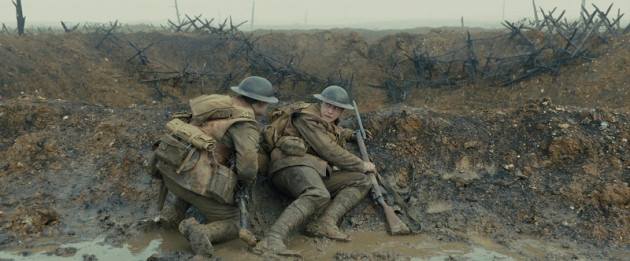
1917
A third crasser explanation for the frequent use of the long take “oner” is for pure commercial reasons. Whether big budget or small budget many one-taker films will mention this aspect as part of their marketing campaign. Even casual movie fans may be enticed by this type of promotion, and definitely the cinephile is an easy target for such marketing strategies (guilty as charged!). It became a major part of the marketing for 1917, and the Netflix show Hill House, with mention of it in trailers, fan sites, filmmaker interviews, and reviews. Many low budget horror films have exploited this in their marketing campaigns as well (Let’s Scare Julie, La Casas Muda). As they become more frequent then it will become harder to market this as a distinguishing feature. But as of now, even with the number of “oners” increasing, we see it still serving as a mark of distinction.
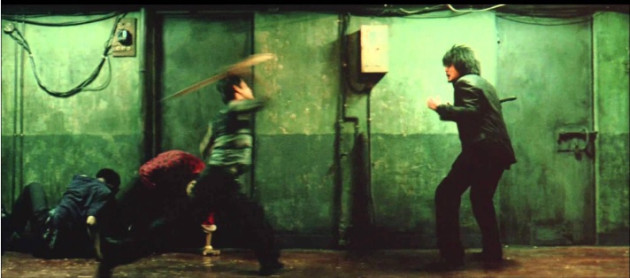
Old Boy
To conclude I will offer my own reason for why the one-take trick works so well within 1917’s plot and narrative scope that is not tied to its technical bravado but is served by it. I will refer to it as the “Relative Labor Equation” rule, where the arduousness of the one long take, with all of its many component parts (camera crew, camera technology, grips, set designers, focus pullers, digital effects artists, lighting technicians) is a production correlative to the onscreen rigors. In the case of 1917 it is the tremendous mental and physical ordeal that the soldiers had to endure during World War 1, especially trench warfare: the rat infestations, lack of proper nutrition, sleep, risk of gangrene, inclement weather, ear splitting sounds, mustard gas attacks, and other endless effrontery to the human body, mind and soul. 1 We see this especially in action films, where impossible fight scenes are underscored by not cutting. Examples include the one against many corridor fight scene in Old Boy (Park Chan-Wook, 2003, South Korea). Which inspired two similar digitally shot oner long take hallway fight scenes in the Marvel TV show Daredevil. And perhaps most impressively, Crazy Samurai Musashi, which was advertised as the 77 minute single take martial arts film where a samurai warrior battles 588 opponents! The music video has a long history of complex single take music videos where audiences are made aware of the labor behind the production. One of the first and still best of these being Lucas’ “Lucas with the Lid Off” music video, directed by Michel Gondry in 1995. In interviews Gondry noted how difficult it was to achieve the single take without edits and how in one of the takes Lucas, who had to scamper around the obstacle course like special sets to reposition himself in the continuous shot, banged his knee against an iron stand and had to finish a take with blood pouring from his gashed knee.
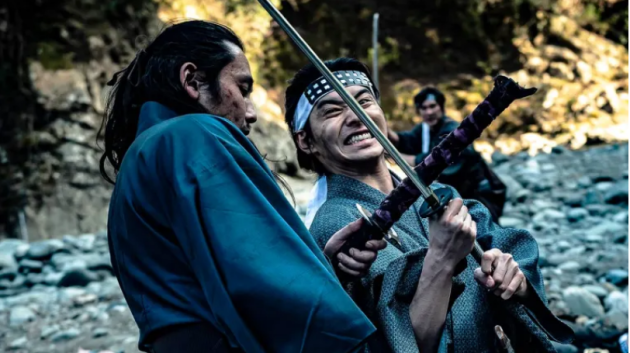
Crazy Samurai Musashi
I am not saying all audiences make a conscious connection between the difficulties of achieving the ‘oner’ long take film and the physical difficulties endured by the actor(s)/artist/crew members, but I would cautiously suggest that it is somewhere in the audience’s mind, either subconsciously or as part of the post-cinematic universe. It is certain that when studios market the oner long take the “labor equation” is a part of what is implied. We see this in the many action films, where impressive fight scenes are handled in one take and either noted in the pre-film hype or talked about on social media afterwards. And in the many one-take music videos as a distinguishing feature and talking point. I doubt most of these fans are tapping in to the aesthetic debates around long take style or the moral ramifications of Bazinian realism. But rather are curious to see the resulting film or music video that the artist/filmmaker went to such great extents to achieve, in this particular way.
Notes
- By chance I viewed in the span of a few days 1917 and Peter Jackson’s monumental World War 1 reconstruction art piece They Shall Not Grow Old (and it is a found footage art piece and not a restoration or documentary). Combined these two films greatly impressed on me the rigors of combat fatigue. And they made me wonder how post-traumatic stress syndrome did not affect every soldier who has ever fought in a war (or that to some extent, it must have). ↩



